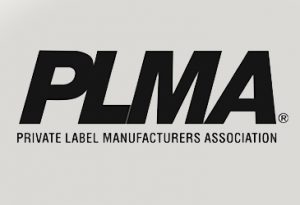Nearly one in five dollars spent at all mass-retail outlets in 2020 went toward the purchase of private-label merchandise.
NEW YORK— Store brands maintained their relative share in the mass retail marketplace in 2020, accounting for about one of every four purchases across major food and nonfood categories, according to the latest figures from the Private Label Manufacturers Association (PLMA).
Nearly one in five dollars spent at all outlets – supermarkets, pharmacy retail, warehouse clubs and dollar stores – went to purchases of store-brand merchandise, according to the NielsenIQ data cited in PLMA’s “2021 Private Label Yearbook,” covering the 52 weeks to December 26, 2020. On a unit basis, store brands accounted for 23% of sales last year.
Prior to 2020, store brands had been eroding the market-leading share of manufacturers’ brands.
 Sales of all brands through mass-retail outlets increased 11.8% to $86 billion last year, according to PLMA, which said the gains were made “despite a number of supply-chain interruptions affecting high-demand categories and a major shift of purchasing from food service to grocery channels as consumers everywhere were forced to adjust their lifestyles around remote schooling and work, and many households were confronted with the loss of income or livelihood.”
Sales of all brands through mass-retail outlets increased 11.8% to $86 billion last year, according to PLMA, which said the gains were made “despite a number of supply-chain interruptions affecting high-demand categories and a major shift of purchasing from food service to grocery channels as consumers everywhere were forced to adjust their lifestyles around remote schooling and work, and many households were confronted with the loss of income or livelihood.”
Store brands accounted for $16.5 billion of sales at mass outlets in 2020, a sum that represents a year-on-year gain of 11.6%, PLMA said.
Diverted food service dollars were welcomed by the grocery industry, but they also posed a massive challenge for its distribution systems, as did considerable stocking up by panicked shoppers, particularly in the first quarter of 2020, PLMA said in its report. Pantry-stocking also contributed to the swelling of last year’s grocery sales total.
“Analysis needs to take these anomalies of the 2020 data into account,” cautioned PLMA president Peggy Davies, “but comparisons to pre-pandemic trends and projections notwithstanding, store brands maintained their well-established position in the marketplace, as retailers and private label manufactures succeeded in supplying the country with critical food and essential non-food products in the face of extreme volatility. The 2020 sales figures bear that out.”
PLMA surmises that price inflation accounted for a significant proportion of last year’s increase in national brands.
The report said 2020 brought a “reversal of trends” in the U.S. supermarket category, which of late had only moderate, mostly inflationary sales growth and declining unit volumes. Store brands factored significantly in this turnaround, PLMA said. The association tabulated an $8.5 billion increase in private-label sales at supermarkets, to a record $27.3 billion, while unit sales were up 7.1%. But manufacturers’ brands fared somewhat better, capturing $403.6 billion in grocery channel sales, an increase of 16% from the year earlier. National brand unit sales increased 9.4%.
The retail pharmacy channel fared less well than others, with store-brand sales declining by $130 million, or 1.7%. On a unit basis, store-brand sales declined 6% in 2020.
NielsenIQ’s Kara Sheesley, vice president retail engagement and U.S. industry relations, cited household panel data for 2020 as an indicator that private label purchases are ingrained in U.S. consumers’ behavior.
“Fully 99% of households told us they bought private label last year,” she said.




You must be logged in to post a comment Login